
History
The Manhattan Shirt Company began in the mid-1850s as a small garment factory operated by Sturgiss, Perkins and Wilson. In the mid-1860s, Jacob Levi, a German immigrant, purchased the factory. In 1868, the mill was described as being two stories and 25 x 100 ft. This mill was located immediately east of the stuccoed brick manufacturing building described on the industrial attachment of this form. This mill was considerably expanded in the early 1880s after Jacob Levi retired from the business giving it over to his partners, brother Louis Levi and Benjamin Wechsler. This establishment was the first to go by the name "Manhattan Shirt Company," which in 1882 was employing about 350 garment workers and producing from 12,000 to 15,000 shirts annually. The company continued to expand through the 1880s to 1910s, and by 1892 had more than doubled in size to a workforce of 850 employees, predominately women. The Manhattan Shirt Company incorporated in the State of New York in 1912 with Lewis Levi as President. This move was apparently to form a conglomerate that also controlled garment factories located in Passaic, N.J.; Salem, N.Y.; and Poultney, Vt., in addition to leased of a number of other garment factories, mostly located in New England. The Manhattan Shirt Company remained in operation through at least the early 1950s in Paterson.
Statement of Significance
The Manhattan Shirt Company was a major Paterson employer from the 1880s to 1950s. Garment manufacture employed large number of women, providing additional wages and employment to Paterson's immigrant households. In and of itself, garment making was not distinctive to Paterson's industrial development, being an industrial sector more closely associated with New York City and parts of New England, but it was part of the Paterson landscape. Although evidence is limited, garment makers may have found it advantageous to be located near the source of silk. Although the Manhattan Shirt Company site has potential significance, its aspects of integrity have been greatly diminished due to demolitions and alterations. Roughly 50 percent of the complex has been razed including the oldest 1880s part of the complex that contained the original factory site and boiler house. The surviving mid-1890s factory with mid-1910s addition at the west end of the site has been heavily altered by application of stucco and replacement and reorientation of the windows. The warehouse at the east end of the site is the most intact resource, but it has no architectural or historical significance on its own merits.
References
Hyde, E. B. Atlas of Passaic County, New Jersey, 1877.
Robinson, E. Atlas of the City of Paterson, New Jersey, 1884.
Robinson, E. Atlas of the City of Paterson and Haledon, New Jersey, 1899.
Mueller, A. H. Atlas of the City of Paterson, New Jersey, 1915.
Sanborn Map Company Insurance Maps of Paterson, New Jersey, 1915.
Sanborn Map Company Insurance Maps of Paterson, New Jersey, 1931.
Sanborn Map Company Insurance Maps of Paterson, New Jersey, 1887.
Sanborn Map Company Insurance Maps of Paterson, New Jersey, 1889.
Trumbull, T. R. A History of Industrial Paterson, 1882.
"Shirt Notes." The Clothier and Furnisher, Vol. 42 (March 1914), p. 99, 1914.
Moody's Investment Moody's Industrial Manual Service, 1917.